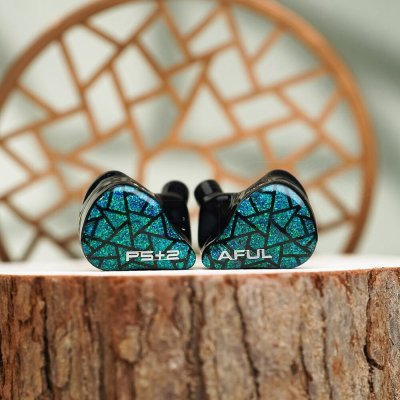Aful Performer 5+2 and Yu9 Que use 2DD+4BA+1Planar and 1DD+3BA driver setups respectively. Aful Performer 5+2 costs $229 while Yu9 Que costs $409. Yu9 Que is $180 more expensive. Yu9 Que holds a clear 0.5-point edge in reviewer scores (7.7 vs 8.1). Yu9 Que carries a user score of 8.5. Yu9 Que has slightly better mids with a 0.3-point edge, Yu9 Que has slightly better treble with a 0.4-point edge and Yu9 Que has slightly better soundstage with a 0.3-point edge.
Insights
| Metric | Aful Performer 5+2 | Yu9 Que |
|---|---|---|
| Bass | 8 | 8.2 |
| Mids | 8 | 8.3 |
| Treble | 7.6 | 8 |
| Details | 7.6 | 7.8 |
| Soundstage | 7.8 | 8.1 |
| Imaging | 7.9 | 7.9 |
| Dynamics | 7.6 | 7.8 |
| Tonality | 7.8 | 8.3 |
| Technicalities | 7.7 | 8 |
Aful Performer 5+2 Aggregated Review Score
Average Reviewer Scores
Average Reviewer Score:
7.7Strongly Favorable
Yu9 Que Aggregated Review Score
Average Reviewer Scores
Average Reviewer Score:
8.1Very Positive
Reviews Comparison
Aful Performer 5+2 reviewed by Jaytiss
Youtube Video Summary
Aful Performer 5+2 lands as a hybrid of the beloved Performer 5 and the punchier Explorer. The unboxing is the familiar P5 affair—same case, same style of tips—nothing flashy, but solid. The shell mirrors the P5 in size with a comfy little stabilizing wing that locks in well. No metal nozzle or front filter here, yet tip retention is secure and hassle-free. The flat 2-pin socket is straightforward, and the stock cable feels thick and supple with a reliable chin slider and handy red/blue channel markers. Overall: understated build, great ergonomics, daily-driver ready.
Sonically, this one aims neutral with a very distinct top end—clean, dynamic, incisive. Think switching from black-and-white to color; cymbals and overtones pop with a slightly crunchy/pristine edge that energizes detail without turning harsh on good recordings. Bass isn’t about sheer quantity; it’s about slam and dynamics—quick on the draw, well-controlled, and satisfying when called upon. Vocals sit a notch forward, microdetail is strong, and the overall presentation is coherent, clear, and technical with convincing stage, resolution, and imaging. Not a treble-shy or bass-bombed tuning—more a refined all-rounder for those who want clarity and bite.
Versus the original P5, the 5+2 fixes the missing “air” and soft edges, trading them for crisper transients and better extension. Compared with Explorer (a value champ), the 5+2 brings superior upper-treble reach, detail, and vocal focus. Against Performer 8 and Cantor, it feels more visceral—the P8 is smoother and more relaxed, while Cantor pulls finer microdetail but with less bass slam. Sets like Dino Quattro or J’s Estrella bring bigger fun or treble theatrics, yet the 5+2’s balance and everyday versatility win more often. Net take: a neutral-leaning, highly technical upgrade that stands tall in its bracket—easy to recommend to anyone chasing clarity, speed, and controlled impact over pure warmth or excess bass.
Jaytiss Youtube Channel
Buy Aful Performer 5+2 on HiFiGO
Ad
Price: $213
Buy Aful Performer 5+2 on HiFiGO
Yu9 Que reviewed by Jaytiss
Youtube Video Summary
The YU9 Que sports a premium, durable resin shell in pure black with a metallic-feeling faceplate and a comfortable design featuring an anti-tragus catch. While the build itself feels handsome and unique, the included cable is criticized as wimpy and unpleasant, with a strong suggestion to upgrade it. Accessories are deemed solid, including a nice selection of tips and a particularly praised case with a soft, luxurious interior.
Sonically, the YU9 Que earns immense praise for its exceptional tuning, described as clean, resolute, and non-fatiguing. It delivers strong, textured bass that avoids being overwhelming, coupled with extremely well-done upper mids. While not class-leading in technicalities like micro-detail or instrument separation, its tonal balance is considered sophisticated and reminiscent of far more expensive sets like the Annihilator, even surpassing the Monarch MKII in tuning preference. It's highlighted as a fantastic all-rounder with a smooth, agreeable signature suitable for long listening sessions.
Despite its modest single dynamic driver + 3BA configuration and $409 price point, the YU9 Que is declared a very special and unique IEM, worthy of the hype it received. The review concludes it's a price leader and a highly competent package from a small brand, offering outstanding value and a beautiful, well-executed design that makes it an easy recommendation for those seeking a smooth, non-fatiguing sound.
Jaytiss Youtube Channel
Aful Performer 5+2 reviewed by Kois Archive
Kois Archive Youtube Channel
Yu9 Que reviewed by Kois Archive
Youtube Video Summary
Yu9 Que arrives with a surprisingly premium unboxing: a crush-resistant carrying case with plush padding, an IEM pouch, microfiber cloth, cable clip, and two ear-tip sets (standard silicone and more premium liquid silicone). A quirky 3D-printed nameplate with serial number and a faceplate etched in a topographic-map motif give it character. The shell is on the larger, wider side—comfortable for many, but small ears should test fit first. The stock cable is just okay (some memory, no chin slider), though it’s offered in 3.5 mm or 4.4 mm terminations.
Tonally, this is a neutral-reference set with a tasteful bass lift—clean impact without throwing off balance. Sub-bass has satisfying thump and texture, though bass-heads coming from sets like Kiwi Ears Punch may find it polite. The mids sit even and accurate—no “vocal magic,” yet clearly above average. Treble stretches well into the air with a touch of brightness that adds crispness and a slightly clinical edge, staying shy of fatiguing. Technical chops are the draw: a decently wide soundstage (roughly 3–4/5 by comparison), standout 3D imaging, and strong resolution/separation make it excellent for gaming—worthy of a two-controller nod—though ultimate detail still trails pricier kilobuck options.
Versus peers: Moondrop Dusk (DSP) is warmer with bass that hits a bit harder, while Yu9 Que is the more neutral, reference-leaning take. Elysian Pilgrim offers smoother treble, but Yu9 Que counters with better bass grip, stage, and imaging. AFUL Performer 7 tilts mild V; choose it for extra mid-bass and forward treble, otherwise Yu9 Que wins on technicality. Mega 5 EST chases the meta target yet stumbles in bass/treble; NiceHCK Rockies refines that approach and might be the more exciting alternative if spending slightly more. Bottom line: the hype is justified—a superb all-rounder around $400 with only the cable begging for an upgrade. It’s a clear pick for neutral/reference fans, though those seeking more “fun” might look elsewhere; call it a pragmatic, two-star recommendation amid a crowded market and likely pre-order waits.
Kois Archive Youtube Channel
Aful Performer 5+2 reviewed by Gizaudio Axel
Gizaudio Axel original ranking
Gizaudio Axel Youtube ChannelYu9 Que reviewed by Gizaudio Axel
Youtube Video Summary
Build & accessories: a hybrid 1DD + 3BA set priced around $399 with a spacious zipper case, multiple silicone tips, pouches, cleaning cloth, and shirt clip. The faceplate’s wavy, stone-like texture looks premium, and the shells use a 2-pin connector. The downside is the stock cable: it’s springy, only in 4.4 mm, and feels below the tier. Fit is serviceable but not ideal—the shell isn’t the most ergonomic, the nozzle lacks a lip, and seating a deeper fit can take a moment; once set, stability is good and tips stayed secure in use.
Sound: this isn’t a “new-meta” curve; it’s a unique, lively tuning. Bass is punchy, dynamic, and highly textured—more physical in practice than the graph suggests, with excellent impact and kick-drum authority. An early rise after 1 kHz pushes vocals front and center for an intimate, engaging presentation without tipping into shout. Treble is refined, sparkly, and well-extended: it is a bright set but avoids harshness, peakiness, sibilance, and fatigue, delivering crisp cymbals and defined transients even for rock and metal at any volume. Technicalities are class-leading under $500 with standout detail retrieval and separation; the one wish is a larger soundstage.
Comparisons & verdict: the Elysian Apostle still wins on bass texture/impact, treble refinement, and overall resolution, but the Yu9 Que offers a convincing “Apostle flavor” at a lower price. Versus Elysian Pilgrim, the Que is fuller and bassier, while Pilgrim’s treble is tamer; versus Volume S, the Que is cleaner, brighter, more detailed as the Volume S trends warmer with more neutral treble; against Dusk DSP, Dusk sounds more natural/balanced but the Que feels more fun and technical. Recommended for those who crave clarity, sparkle, and engagement without fatigue; less ideal if treble-sensitive or preferring a warm, relaxed tonality, and worth demoing for comfort. A top contender and serious gatekeeper around $400—final rating: 4.5/5 with a strong recommendation.
Gizaudio Axel original ranking
Gizaudio Axel Youtube ChannelAful Performer 5+2 reviewed by Audionotions
Yu9 Que reviewed by Audionotions
Aful Performer 5+2 reviewed by Jays Audio
Youtube Video Summary
Performer 7 lands with a neutral-balanced, laid-back tuning and good treble reach. The presentation is clean and generally safe, though there’s a touch of sizzly “planar-ish” timbre up top. Technicals are solid for ~$200—slightly behind sets like Quintet and Super Mix 4, about on par with Nova. Bass from the dual 6 mm DDs is tight, controlled, and free of bleed, but lacks the slam and rumble of competitors using larger drivers; mids are well separated with decent layering.
The weak spot is vocal extension: a push around 1.5 kHz tries to bring them forward, but a dip through 3–6 kHz keeps them from opening up. Tamer upper-mids help avoid fatigue for rock/metal, yet the modest low-end impact leaves drums and basslines feeling uneventful. It’s a mid-volume set that doesn’t scale well—turning it up accentuates the 1.5 kHz emphasis and treble sizzle. Treble isn’t peaky, just a bit glassy at times; for K-pop the smoother mids can work if less extended vocals are acceptable.
As a value play, there are stronger options: Nova, Chopan, and Super Mix 4 offer better bang-for-buck; for a similar clean/neutral target, Tanchjim Origin sounds more natural with better bass texture and vocal reach, and DynaQuattro adds sub-bass and fuller vocals—none with the planar-ish timbre. Even AFUL’s own P5 is cheaper and more fun, while the Explorer undercuts the price and scales impressively. In today’s crowded market, P7 is a competent all-rounder but not distinctive enough to stand out.
Jays Audio Youtube Channel
Yu9 Que reviewed by Jays Audio
Youtube Video Summary
YU9 Que presents a balanced, almost neutral tuning with a tasteful touch of mid-bass for warmth and punch. Treble is clean and controlled—more clarity than “sizzle”—so detail comes through without harshness, while mids keep vocals natural rather than forward or thin. Technical performance sits in the “solid for the price” camp: separation and imaging are tidy, but not the kind of hyper-etched sparkle that chases wow factor.
In practice, it shines with slower pop, R&B, acoustic and vocal-centric tracks where its coherence and smoothness pay off; those seeking big sub-bass drama or ultra-aerated treble fireworks may find it a touch polite. Versus brighter, more contrasty sets, the Que trades spectacle for musicality and long-session comfort, making value hinge on whether a refined, low-fatigue signature is preferred over maximum excitement at the price point.
Jays Audio Youtube Channel
Aful Performer 5+2 reviewed by Web Search
The AFUL Performer 5+2 (also listed as “Performer 7”) uses a 2DD+4BA+1 micro planar driver array and AFUL’s LC-network crossover plus a 3D-printed acoustic tube system, aiming for clean band splits without smearing. The shell also integrates a high-damping air-pressure balance system, a design AFUL has used across its line. Official listings put MSRP around $229 and outline the same core tech features.
Tonally it trends neutral with a sub-bass lift: bass has solid depth and texture, mids stay relatively linear, and the presence/treble region adds energy without veering into sharpness on most chains. Multiple reviews characterize it as warm-neutral with bass boost or slightly V-shaped depending on perspective, which matches listening notes about a lively but controlled upper end. Sensitivity and load are portable-friendly (≈109 dB, 15 Ω), so it reaches performance without demanding amplification.
Technicalities are competitive for the class: imaging is tidy with good instrument separation, micro-detail retrieval is above average, and soundstage is moderate (more width than depth). Build and comfort are typical resin-shell fare; some users note occasional lower-treble bite depending on tips and recordings, so treble-sensitive listeners may wish to pair accordingly. Overall value is strong at its price, especially if a clean, bass-supported neutral curve is the priority.
Yu9 Que reviewed by Web Search
The YU9 Que is a hybrid IEM using 1 dynamic driver + 3 balanced armatures, positioned in the mid-upper price tier with an MSRP around $399. Retail listings confirm the configuration (10 mm LF DD with three Knowles BA units) and current pricing in USD and MYR, placing it among competitors that emphasize tonal refinement over sheer technical fireworks.
Community impressions describe a balanced/neutral tonality with a tasteful bass lift, smooth upper-mids that avoid glare, and treble that leans non-sibilant. Subjective reports on Head-Fi and Reddit consistently frame the Que as an all-rounder that favors coherence and long-term listenability over maximum micro-detail.
Technically, listeners note solid imaging and macrodynamics with competent detail retrieval, though not class-leading for the price. The manufacturer has also published frequency-response plots (IEC711 and BK5128 rigs), which aligns with the community’s take that the Que targets a broadly neutral/balanced signature rather than an aggressive V-shape. Overall value is credible at its MSRP if you prioritize tonal balance and comfort over ultra-analytical presentation.
Aful Performer 5+2 (more reviews)
Aful Performer 5+2 reviewed by Z-Reviews
Youtube Video Summary
Naming drama aside (P5+2? just call it Performer 7), this Aful packs a quirky driver party: 2DD for low end, 4 BA split across mids/treble, plus a tiny micro-planar for the highest sparkle, all marshaled by Aful’s neat miniature crossover. The shells are lightweight, comfy and prettier than they need to be; the cable feels “don’t bother swapping” nice, with 3.5 or 4.4 options. The box is loaded with silicone tips but no foam—a miss, because the right seal changes everything. Price target sits around $250, which sets expectations high but not ridiculous.
Stock silicone yields a surgical, respectful tuning with bass that skews neutral and controlled. Swap to well-sealing foam or hybrids and feed a juicy source (warm Class A or tubes) and the set wakes up—stage snaps into a cohesive scene right in front, imaging gets laser-etched, and that micro-planar adds a pinch-of-salt treble spice without turning harsh. It’s an up-close presentation—sometimes almost claustrophobically detailed—in the best way: think “men with trumpets in the head,” precise placement, and excellent extension up top. Not as rowdy as the Explorers; more like a surgeon in a Hawaiian shirt—technical, but with a wink.
Practical upside: the clarity and positioning make this great for gaming and even viable for mixing/mastering checks; just don’t crank it into pain territory. Bass stays tight and responsive, treble sails high, and coherence holds. Tip and source matter a lot: with foam + warm power, it sings; with plain silicone, it’s merely polite. Final tally: a confident 8.5/10—doing a lot right at its price, dinged half a point for making everyone do math on the name.
Z-Reviews Youtube Channel
Aful Performer 5+2 reviewed by Audio Amigo
Youtube Video Summary
The AFUL Performer 5+2 (Performer 7 / P7) takes the P5 recipe and adds a second 6 mm dynamic for the lows and a micro-planar for the highs, nudging MSRP to $240. Unboxing mirrors the P5: nine pairs of tips and a decent case, but the accessories feel bare-bones at this price—no foam tips and a non-modular cable, even though the included 8-wire is supple and well-behaved. Build is classic AFUL: 3D-printed resin, blended nozzle (no mesh or lip—watch tip retention), single rear vent, and striking blue-green mosaic shells inspired by Suzhou gardens—cool-wall approved with four compliments to one “meh.” Fit is semi-custom and a touch chunkier than P5; comfortable for most, a conditional pass for small ears. Note a sporadic batch quirk: some units have over-tight 2-pin sockets; exchanges fixed it for affected buyers.
Tuning sits in warm-leaning neutral territory. The dual dynamics deliver punchy, textured bass that rumbles without bloating; guitars and drums carry convincing weight. Mids are the star—rich, full-bodied, vocal-forward without shout, with clean separation and natural tone. Treble from the micro-planar is smooth yet energetic: cymbals and vocal harmonics sparkle, special effects have bite and body, and only treble-sensitives may find hot mixes a bit lively. Technicalities impress for the money—detail retrieval and nuance feel a class up—while stage and imaging are solid rather than showy.
Against peers: the Tangzu x HBB budget pick mirrors the overall tonality but P7 offers higher resolution and more treble finesse; the planar “Heyday” alternative is brighter/faster with leaner bass; versus Performer 5, P7 brings tighter low-end, smoother treble, and better extremes detail; the Fresh-collab competitor pushes vocals further forward with bigger stage but leaner lower mids. Verdict: a versatile all-rounder that suits broad libraries and even content creation thanks to its balanced tonality and detail. Not for bassheads, trebleheads, or strict Harman-lean seekers, and the accessory pack/cable quirk holds it back from a slam-dunk. For roughly $240, though, it’s a brilliant, resolving upgrade in the AFUL line.
Audio Amigo Youtube Channel
Aful Performer 5+2 reviewed by Super* Review
Youtube Video Summary
Aful’s Performer 5+2 upgrades the original hybrid with 2DD + 4BA + 1 micro-planar tweeter and lands around $240–$250. The unboxing is practical: three sets of silicone tips, a pocketable puck case, and a soft, nicely draping cable (available in 4.4 or 3.5), though the braid can look a bit loose and the pre-formed hooks run large. The resin shells shift between blue and green under different light; fit is medium-large, very stable, and comfortable once the right tips are found. Note the narrow nozzle without a retaining lip and partially exposed bores/filters—tip grip is key and a little care prevents ear-gunk ingress.
Tonally this leans mild V-shaped: a clean midrange with a confident bass boost, a touch of lower-treble presence for bite, and well-extended air up top. The result is more incisive and punchy than the original P5, with clearer on/off transients that aid separation and layering. Trade-offs show as a hint of gritty/plasticky treble texture on cymbals and brushes—not harsh, but less natural than ideal—while the bass stays tight and exciting.
Against Aful’s Explorer, this sounds brighter, more spacious, and more technical; Explorer plays warmer/denser with smoother treble but less openness. Versus the pricier Thieaudio Oracle MK3, tuning is broadly similar: Oracle is smoother and deeper with a softer attack, while the Performer 5+2 brings more snap and engagement for less money. As a modern mid-tier hybrid, it absolutely still has a place—energetic, spacious, and well-executed—earning a solid four stars.
Super* Review original ranking
Super* Review Youtube ChannelAful Performer 5+2 reviewed by Tim Tuned
Yu9 Que (more reviews)
Yu9 Que reviewed by Paul Wasabii
Youtube Video Summary
At ~$400, YU9 Audio Que sets a new bar for the bracket: a 1DD+3BA hybrid with a modest bass shelf, slightly forward mids, and linear treble extension that sounds more speaker-like than typical IEMs. The presentation is exceptionally polished and quiet-backgrounded, yielding crisp separation, convincing imaging, and staging in depth, width, and height that resembles far pricier gear.
The low end brings tactile mid-bass impact with deep, controlled sub-bass, pairing naturally with that extended, peak-free top end; the result is a true playlist killer across EDM, rock, vocal, and classical. Nitpicks exist: mids can sit a touch forward depending on track and the set rewards a slightly higher volume and a secure, deeper fit, while V-shape fans may find it too boring.
Compared with favorites like Dusk, Cadenza 4, and Volume S, Que keeps their strengths but fixes common complaints by delivering fuller bass weight, cleaner openness, and more realistic attack and dynamics. It does not need giant-killer claims to stand out; at this price it is simply class-leading.
Paul Wasabii Youtube Channel
Yu9 Que reviewed by Fox Told Me So
Tuning is clean, neutral, and slightly V-shaped: bass is tight, bouncy, and textured; mids sit slightly forward thanks to extra 700 Hz–2 kHz gain, giving vocals a bigger image; treble leans bright with a 4–5 kHz push for clarity, rolling off naturally rather than chasing EST-style air. Sibilance can appear (on “th” or “tsu”), but not harsh.
Stage favors width over depth—impressively wide at the price, with neat, well-ordered placement and strong separation. Resolution is crisp, background clean, every note clearly etched.
Fox Told Me So original ranking
Fox Told Me So Youtube ChannelYu9 Que reviewed by Precogvision
Youtube Video Summary
Yu9’s Que lands as a “safer Annihilator”: a warmer, scaled-back take that pushes ample sub-bass while keeping the rest tastefully controlled. The low end feels liquidy and bouncy, underpinning an aggressive 1–3 kHz rise with a gentle 3–5 kHz taper, so vocals sit upfront and crisp yet remain remarkably smooth thanks to the extra low-end warmth. Treble is slightly scooped around 5–6 kHz and then climbs in small, well-placed peaks out to ~15–18 kHz, yielding excellent extension that feels on par with sets like Moondrop Variations in this range.
What makes it pop is the value proposition: at $400, the overall resolution, tonal balance, and staging read far pricier—more like the $700–800 bracket. With its engaging sub-bass lift, lucid mids, and airy yet controlled top end, Que comes off as a polished, crowd-friendly tuning that still excites detail chasers. If momentum holds, this looks like the next big thing around the $400 mark.
Precogvision Youtube Channel
Yu9 Que reviewed by Head-Fi.org
Aful Performer 5+2 Details
Driver Configuration: 2DD+4BA+1Planar
Tuning Type: Neutral with Bass Boost
Brand: AFUL Top AFUL IEMs
Price (Msrp): $229
Support our free service! Buying through our affiliate links costs you nothing extra:
Yu9 Que Details
Driver Configuration: 1DD+3BA
Tuning Type: Neutral with Bass Boost
Price (Msrp): $409
Support our free service! Buying through our affiliate links costs you nothing extra:
Aful Performer 5+2 User Review Score
Average User Scores
Average User Score: n/a
Based on 0 user reviews
No user reviews yet. Be the first one who writes a review!
Yu9 Que User Review Score
Average User Scores
Average User Score:
Based on 1 user reviews
8.5Excellent
Aful Performer 5+2 Gaming Score

Gaming Score & Grade
- The gaming score is prioritizing technical capabilities of the IEM (Separation, Layering, Soundstage) and good value.
Gaming Score
7.7Gaming Grade
AYu9 Que Gaming Score

Gaming Score & Grade
- The gaming score is prioritizing technical capabilities of the IEM (Separation, Layering, Soundstage) and good value.
Gaming Score
7.8Gaming Grade
AAful Performer 5+2 Scorings
Average Technical & Tuning Grades
Average Tunign Grade
A- Tuning feels well executed, keeping a natural flow across the spectrum. Switching genres feels seamless.
Average Technical Grade
A- Overall technical control is strong, presenting instruments with clarity and sensible staging. Textures are portrayed with satisfying clarity.
Yu9 Que Scorings
Average Technical & Tuning Grades
Average Tunign Grade
A+- Tuning feels refined, blending frequencies with convincing realism and engagement. Transitions between registers feel effortless.
Average Technical Grade
A+- You get an articulate, polished performance with immersive stage depth and great control. There's a sense of polish across the whole spectrum.
Aful Performer 5+2 User Reviews
"This is an example review"
Pros
- Example pro 1
- Example pro 2
Cons
- Example con 1
- Example con 2
Share your experience and build your personal ranking list.
You need to be signed in to write your own reviewYu9 Que User Reviews
Share your experience and build your personal ranking list.
You need to be signed in to write your own reviewTastefully tuned IEM. It gives some unique colorations to the sound, making vocals sound pretty crisp and clean but in a tasteful way. Add a very satisfying amount of bass (including mid-bass!). Treble is top-notch.
Pros
Tuning, especially bass and treble. But mids do not disappoint as well.Cons
I wouldn't describe this as neutral or even reference sounding. Soundstage could be wider.Find your next IEM:
IEM Finder Quiz
newIEM Comparison Tool
newVS






























